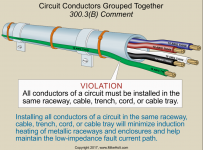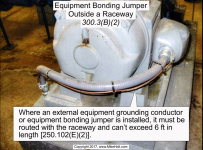I can understand the physics of current carrying conductors being run in close proximity to mitigate electric fields. But don't see why a normally non current carrying conductor, who's only purpose is to open the OCPD in the event of a fault would have to be in close proximity.
You are using an out of date browser. It may not display this or other websites correctly.
You should upgrade or use an alternative browser.
You should upgrade or use an alternative browser.
No ground wire
- Thread starter earthstar
- Start date
- Status
- Not open for further replies.
LarryFine
Master Electrician Electric Contractor Richmond VA
- Location
- Henrico County, VA
- Occupation
- Electrical Contractor
Because the well casing qualifies as an electrode.Why would it? (I don't understand the question)
ptonsparky
Tom
- Occupation
- EC - retired
Put the Service disconnect at the well.Because the well casing qualifies as an electrode.
Most well casings are not metal any more.
- Location
- Illinois
- Occupation
- retired electrician
Because where AC current flows in conductors that are physically separated from each other the impedance goes up as a result of inductive reactance. This increased impedance restricts the flow of fault current and can result in a much longer clearing time for the OCPD. Often placing the trip time into the short time or even long time part of the trip curve instead of being in the instantaneous part of the curve where it should be.I can understand the physics of current carrying conductors being run in close proximity to mitigate electric fields. But don't see why a normally non current carrying conductor, who's only purpose is to open the OCPD in the event of a fault would have to be in close proximity.
As I recall, there is a table in the IEEE Green Book, that shows a 12" separation doubles the impedance of the fault return path.
- Location
- Illinois
- Occupation
- retired electrician
Given the 600' from the power source, I don't see the well casing as being a required grounding electrode.Because the well casing qualifies as an electrode.
250.50 Grounding Electrode System.
All grounding electrodes as described in 250.52(A)(1) through (A)(7) that are present at each building or structure served shall be bonded together to form the grounding electrode system ...
kwired
Electron manager
- Location
- NE Nebraska
- Occupation
- EC
correct on that. They might have metal above grade and for first few feet below grade but are usually non metallic the rest of the way.Put the Service disconnect at the well.
Most well casings are not metal any more.
Good stuff, would a solution be to put a fused disconnect at the pump house with a smaller fuse than you would normally use?where AC current flows in conductors that are physically separated from each other the impedance goes up as a result of inductive reactance. This increased impedance restricts the flow of fault current and can result in a much longer clearing time for the OCPD.
- Location
- Illinois
- Occupation
- retired electrician
The only solution is to properly install an EGC.Good stuff, would a solution be to put a fused disconnect at the pump house with a smaller fuse than you would normally use?
- Location
- New Jersey
- Occupation
- Journeyman Electrician (retired)
It is not required to be used as part of the GES.Because the well casing qualifies as an electrode.
ptonsparky
Tom
- Occupation
- EC - retired
No.Good stuff, would a solution be to put a fused disconnect at the pump house with a smaller fuse than you would normally use?
ptonsparky
Tom
- Occupation
- EC - retired
How big is the proposed motor?
Not that it changes the answer to the original question.
Not that it changes the answer to the original question.
Based on my experience with customers and well pumps, my 1st question would be "do you have 3 phase power at the source ?" 
There is an amazing amount of misunderstanding on phases and voltage by folks not in our field.
If 3 phase is available, then don's Post 28 sums it up.
There is an amazing amount of misunderstanding on phases and voltage by folks not in our field.
If 3 phase is available, then don's Post 28 sums it up.
kwired
Electron manager
- Location
- NE Nebraska
- Occupation
- EC
There is quite a few three phase well pumps anymore run by a VFD with single phase inputBased on my experience with customers and well pumps, my 1st question would be "do you have 3 phase power at the source ?"
There is an amazing amount of misunderstanding on phases and voltage by folks not in our field.
If 3 phase is available, then don's Post 28 sums it up.
- Location
- Chapel Hill, NC
- Occupation
- Retired Electrical Contractor
Why does the customer want a 3 phase pump?
jimport
Senior Member
- Location
- Outside Baltimore Maryland
- Occupation
- Master Electrician
I seem to remember Mike having a graphic that showed a EGC strapped to the outside of a conduit. Really seems the same as retrofit of a EGC to an older two wire system to allow 3 prong devices.
kwired
Electron manager
- Location
- NE Nebraska
- Occupation
- EC
I believe there is length limitations where the EGC is permitted to be outside the raceway and mostly is for flexible conduits. Not sure why it was ever permitted other than maybe for use with segments of flexible metal conduits where a bonding jumper is required around the flex but no EGC was pulled inside raceway.I seem to remember Mike having a graphic that showed a EGC strapped to the outside of a conduit. Really seems the same as retrofit of a EGC to an older two wire system to allow 3 prong devices.
The impedance issues still exist with running a separate EGC to old two wire wiring methods. Circuit length is often short enough it isn't too big of an issue. You still can't run a new install of two wire and route an EGC separately, it is just one option for dealing with something existing.
electrofelon
Senior Member
- Location
- Cherry Valley NY, Seattle, WA
- Occupation
- Electrician
Yeah, I wonder if this is a case of a customer wanting something fancy and expensive for some perceived but invalid reason. I am generally not a fan of constant pressure/ variable speed water systems. It's more expensive and more stuff to fail. Many pressure tanks are undersized and this can lead to cycling or noticeably variable water pressure. Usually just providing a proper or even oversized pressure tank is all one needs.Why does the customer want a 3 phase pump?
- Location
- Chapel Hill, NC
- Occupation
- Retired Electrical Contractor
I seem to remember Mike having a graphic that showed a EGC strapped to the outside of a conduit. Really seems the same as retrofit of a EGC to an older two wire system to allow 3 prong devices.

303.(B)(2) Grounding and Bonding Conductors.
Equipment grounding conductors shall be permitted to be installed outside a raceway or cable assembly where in accordance with the provisions of 250.130(C) for certain existing installations or in accordance with 250.134, Exception No. 2, for dc circuits. Equipment bonding conductors shall be permitted to be installed on the outside of raceways in accordance with 250.102(E).
This is for bonding jumpers

wwhitney
Senior Member
- Location
- Berkeley, CA
- Occupation
- Retired
It bears repeating that the 300.3(B) graphic only applies to ferrous raceways, as 300.3(B)(3) would allow the EGC outside the raceway or cable for nonferrous wiring methods. The graphic could use updating to reflect that.
Cheers, Wayne
Cheers, Wayne
ptonsparky
Tom
- Occupation
- EC - retired
Even lots of them.There is quite a few three phase well pumps anymore run by a VFD with single phase input
- Status
- Not open for further replies.
